Sarracenia Purpurea Uses, Benefits, And Remedies
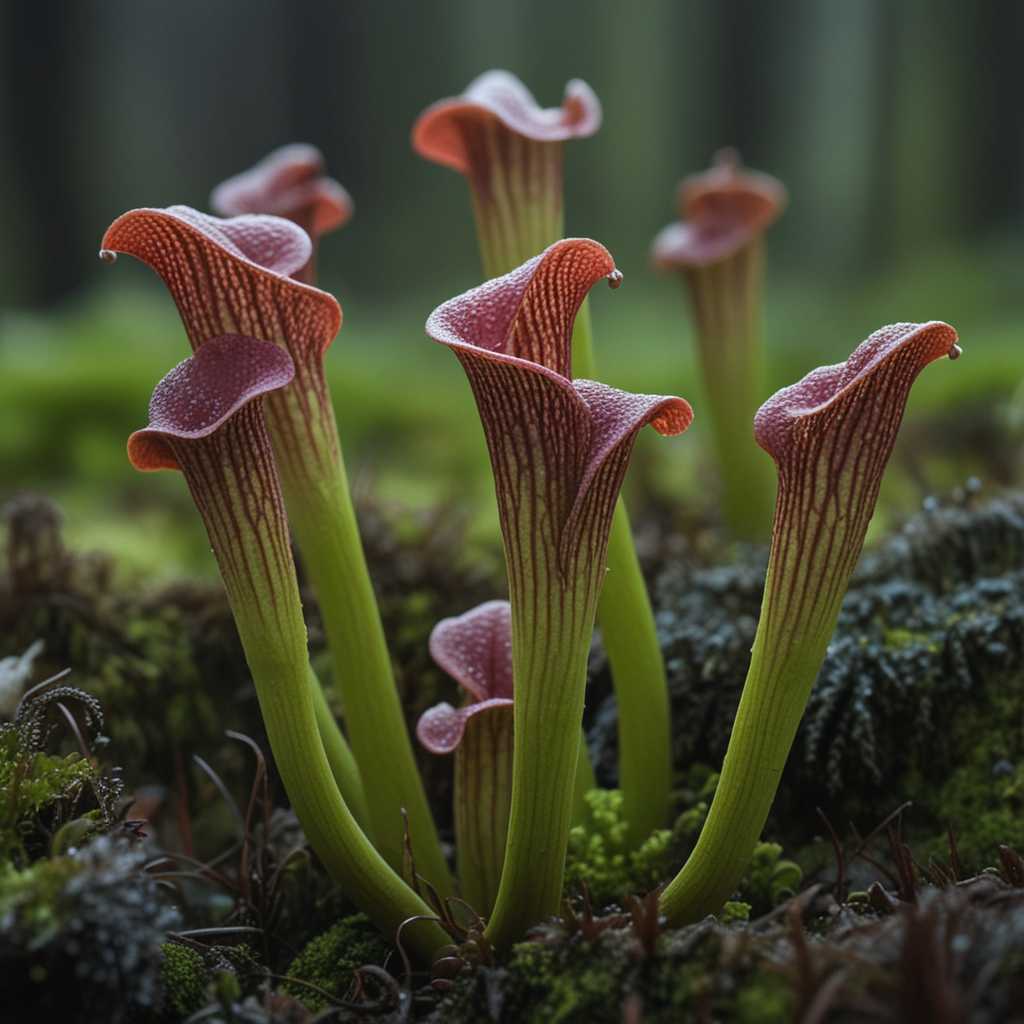
Sarracenia purpurea, commonly known as the purple pitcher plant, is a carnivorous plant native to North America that is used in herbal medicine for its medicinal properties.
This herb is valued for its ability to support digestive health, reduce inflammation, and promote detoxification.
The bioactive constituents in Sarracenia purpurea include tannins, flavonoids, and phenolic compounds, which contribute to its therapeutic actions.
Herbal preparations such as infusions, tinctures, and decoctions can be made from the plant to harness its beneficial effects.
This page analize the most important medicinal aspects of Sarracenia purpurea.
- Health Benefits
- Bioactive Constituents
- Medicinal Parts
- Herbal Preparations
- Side Effects of sarracenia purpurea
Health Benefits
Sarracenia purpurea kills bacteria infections due to its high concentration of antimicrobial compounds, such as phenolic acids and flavonoids, which disrupt bacterial cell membranes and inhibit their growth.
It prevents food poisoning by neutralizing harmful pathogens like *Salmonella* and *E. coli* through its natural antibacterial properties, reducing the risk of contamination. It reduces fever quickly because it possesses antipyretic effects that help regulate body temperature by promoting perspiration and reducing inflammatory responses. It prevents tooth decay by inhibiting the growth of *Streptococcus mutans*, a primary cause of dental caries, through its acidic properties and antibacterial action.
It eases digestive issues by stimulating the production of digestive enzymes and reducing inflammation in the gastrointestinal tract, promoting overall digestive health.
The 10 best health benefits of Sarracenia purpurea are shown in the image below.
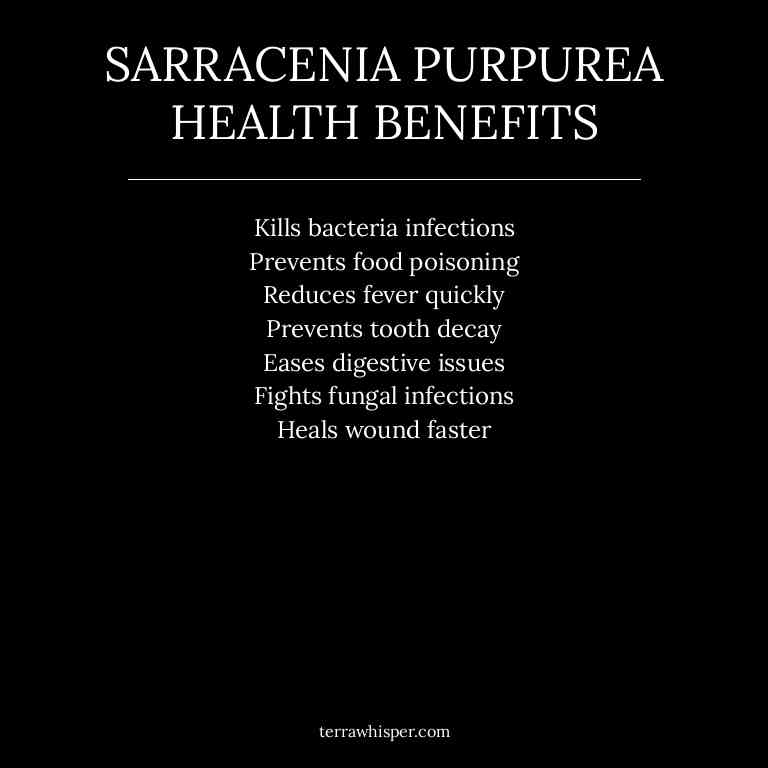
The list below give a brief description of the 10 best health benefits of Sarracenia purpurea.
- Kills Bacteria Infections: Sarracenia purpurea contains antimicrobial compounds that help eliminate harmful bacteria, supporting the body's fight against bacterial infections.
- Prevents Food Poisoning: The herb's antibacterial properties can inhibit the growth of foodborne pathogens, reducing the risk of food poisoning.
- Reduces Fever Quickly: Sarracenia purpurea may help lower body temperature through its cooling and anti-inflammatory effects, aiding in the reduction of fever.
- Prevents Tooth Decay: The herb's antimicrobial and anti-inflammatory properties can help prevent the buildup of harmful bacteria that cause tooth decay.
- Eases Digestive Issues: Sarracenia purpurea can soothe the digestive system and reduce inflammation, helping to alleviate issues like indigestion and bloating.
- Fights Fungal Infections: The herb contains antifungal compounds that can inhibit the growth of fungi, aiding in the treatment of fungal infections.
- Heals Wound Faster: Sarracenia purpurea promotes tissue regeneration and has anti-inflammatory properties that can accelerate the healing of wounds.
Bioactive Constituents
Sarracenia purpurea terpenes contribute to the plant's natural defense mechanisms against herbivores and pathogens, and they may also possess antimicrobial and anti-inflammatory properties.
Tannins in Sarracenia purpurea are known for their astringent effects and ability to bind with proteins, potentially aiding in wound healing and reducing inflammation. Phenolic acids present in the plant have antioxidant properties that help neutralize free radicals, thus protecting cells from oxidative damage. Sterols, such as β-sitosterol, are found in Sarracenia purpurea and may support skin health and have anti-inflammatory effects when applied topically.
These medicinal constituents collectively make Sarracenia purpurea a valuable resource in traditional and modern herbal medicine, offering potential therapeutic applications in treating various ailments.
The 11 best bioactive constituents of Sarracenia purpurea are shown in the image below.
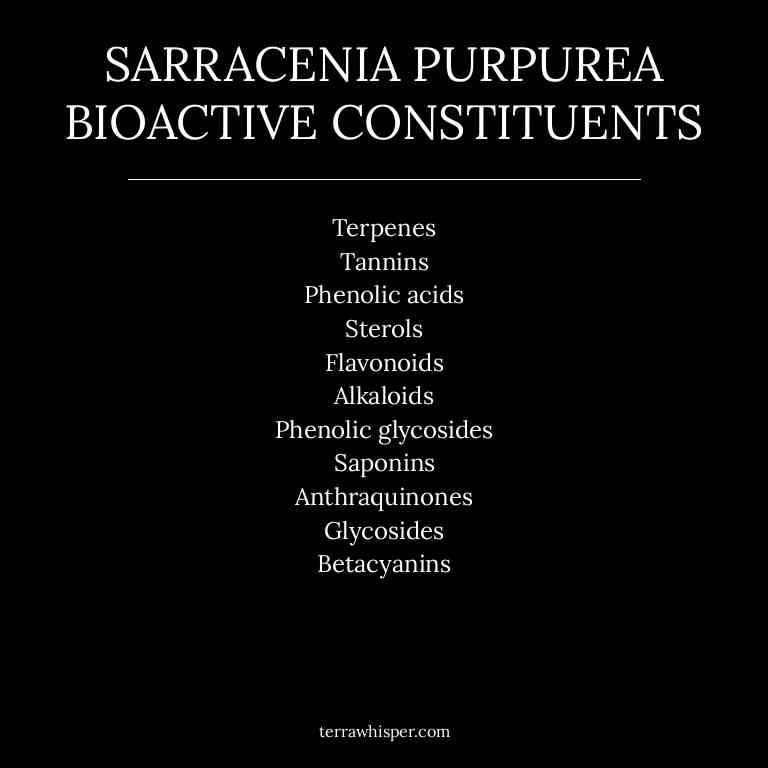
The list below give a brief description of the 10 best bioactive constituents of Sarracenia purpurea.
- Terpenes: Terpenes are a large and diverse class of organic compounds, often responsible for the aroma and flavor of plants, and may have various biological activities including anti-inflammatory and antimicrobial properties.
- Tannins: Tannins are a group of polyphenolic compounds that can bind to proteins and are known for their astringent properties, antioxidant effects, and potential anti-inflammatory and antimicrobial actions.
- Phenolic Acids: Phenolic acids are organic compounds with antioxidant properties that can help neutralize free radicals, reduce inflammation, and support overall cellular health.
- Sterols: Sterols are lipid-like molecules that play a role in cell membrane structure and may have anti-inflammatory and cholesterol-lowering effects in the body.
- Flavonoids: Flavonoids are a group of plant secondary metabolites with strong antioxidant properties, known to support cardiovascular health and have anti-inflammatory and neuroprotective effects.
- Alkaloids: Alkaloids are nitrogen-containing organic compounds that often have significant physiological effects on humans and animals, including potential therapeutic and toxic properties.
- Phenolic Glycosides: Phenolic glycosides are compounds formed by the attachment of phenolic groups to sugar molecules, often exhibiting antioxidant and anti-inflammatory properties.
- Saponins: Saponins are plant-derived compounds that can exhibit detergent-like properties, may have anti-inflammatory and antimicrobial effects, and are known to support immune function.
- Anthraquinones: Anthraquinones are organic compounds with a wide range of biological activities, including laxative, antimicrobial, and anti-inflammatory properties.
- Glycosides: Glycosides are compounds consisting of a sugar molecule bonded to a non-sugar component, often having medicinal properties such as cardiovascular support and anti-inflammatory effects.
- Betacyanins: Betacyanins are red and purple pigments found in certain plants, known for their antioxidant properties and potential health benefits including anti-inflammatory and detoxifying effects.
Medicinal Parts
Sarracenia purpurea, commonly known as the purple pitcher plant, contains various parts that have been traditionally used for medicinal purposes.
The leaves, which form the distinctive pitcher-shaped structures, are particularly valued for their ability to absorb and concentrate nutrients, which may contribute to their potential medicinal properties. The pitchers themselves contain a mixture of digestive enzymes and acidic compounds that may support digestive health and have antimicrobial effects.
Additionally, the nectar and other secretions from the plant have been used in traditional medicine to treat ailments such as respiratory infections and skin conditions.
Herbal Preparations
Sarracenia purpurea teas are traditionally prepared by steeping the dried leaves or flowers in hot water, often used to harness the plant's purported medicinal properties.
These teas are believed to support digestive health and may help alleviate symptoms of indigestion or inflammation. The process of making the tea is straightforward, requiring only the herb and hot water, though some preparations may include additional ingredients for enhanced efficacy. However, due to the plant's natural acidity and potential for irritation, it is important to use it in moderation and consult a healthcare professional before regular use.
In addition to teas, Sarracenia purpurea can be used to make decoctions, mucillages, tinctures, and poultices, each offering different therapeutic benefits based on the preparation method. Decoctions involve boiling the plant material for a longer period, while mucillages are made by soaking the leaves to extract their gel-like substance, which is thought to have soothing properties. Tinctures, created by soaking the herb in alcohol, are used for more potent internal or external applications, and poultices, made by crushing the plant and applying it directly to the skin, are often used for topical relief.
Each of these preparations reflects the versatility of Sarracenia purpurea in traditional herbal medicine.
The 10 best herbal preparations of Sarracenia purpurea are shown in the image below.
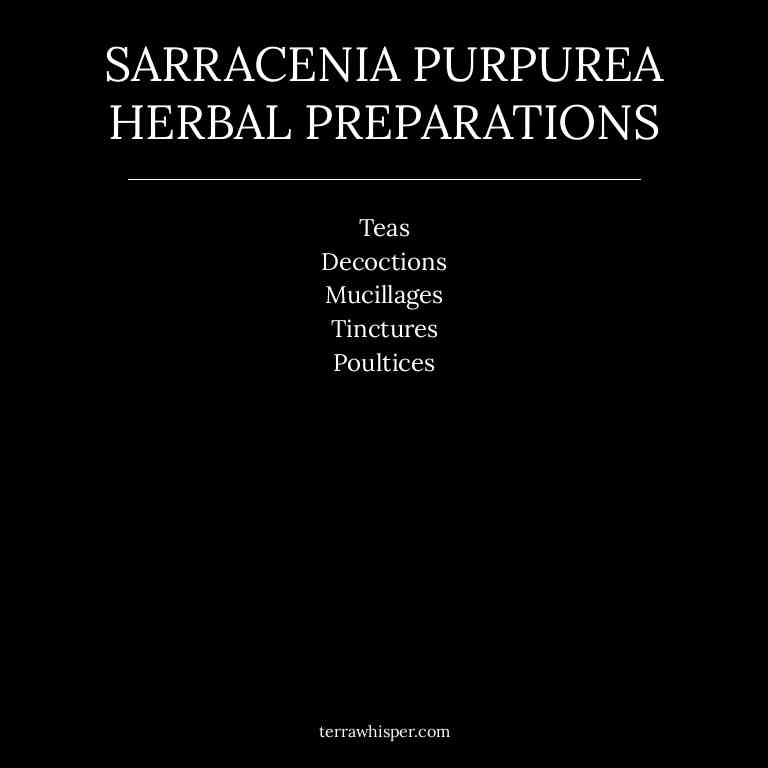
The list below give a brief description of the 10 best herbal preparations of Sarracenia purpurea.
- Teas: Sarracenia purpurea teas are used to support respiratory health, aid digestion, and provide mild diuretic effects due to the plant's natural compounds.
- Decoctions: Sarracenia purpurea decoctions are valued for their ability to soothe inflammation and support detoxification processes in the body.
- Mucillages: The mucillages of Sarracenia purpurea are used to coat and protect the digestive tract, alleviate irritation, and promote healing of mucous membranes.
- Tinctures: Sarracenia purpurea tinctures are used to harness the plant's potent properties for immune support, anti-inflammatory effects, and skin healing.
- Poultices: Sarracenia purpurea poultices are applied externally to reduce inflammation, soothe skin irritations, and promote healing of wounds and infections.
Side Effects of sarracenia purpurea
Sarracenia purpurea triggers skin rashes due to its irritant compounds, which can cause an allergic reaction in sensitive individuals.
Sarracenia purpurea leads to skin itching as the plant's bioactive substances may stimulate nerve endings, resulting in an itchy sensation. Sarracenia purpurea may cause skin irritation because of its high concentration of alkaloids and other phytochemicals that can inflame the skin.
Sarracenia purpurea causes skin irritation and explains why due to the presence of enzymes and organic acids that break down the skin's protective barrier, leading to redness and discomfort.
The 11 most common side effects of Sarracenia purpurea are shown in the image below.
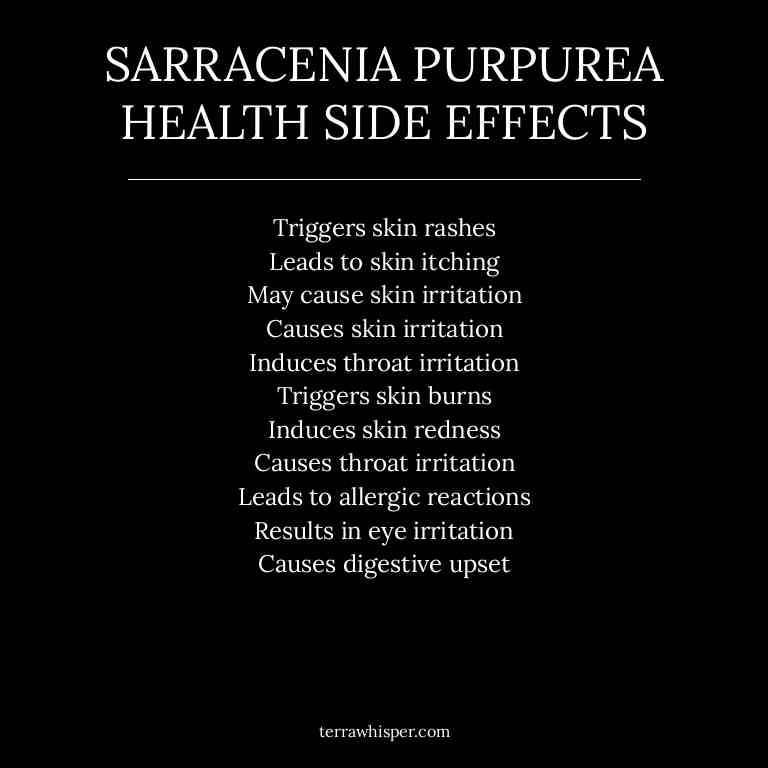
The list below give a brief description of the 11 most common side effects of Sarracenia purpurea.
- Triggers Skin Rashes: Contact with Sarracenia purpurea may cause an allergic reaction leading to the development of skin rashes.
- Leads To Skin Itching: Exposure to the herb can result in an itchy sensation on the skin due to irritation or allergic response.
- May Cause Skin Irritation: The herb has the potential to irritate the skin, causing redness or a burning sensation upon contact.
- Causes Skin Irritation: Direct contact with Sarracenia purpurea can lead to skin irritation, resulting in discomfort and inflammation.
- Induces Throat Irritation: Inhaling particles or consuming the herb may irritate the throat, causing a sore or scratchy sensation.
- Triggers Skin Burns: Prolonged or direct contact with the herb can lead to skin burns, particularly in sensitive individuals.
- Induces Skin Redness: The herb may cause redness on the skin due to an allergic reaction or irritation upon contact.
- Causes Throat Irritation: Consuming or inhaling Sarracenia purpurea can cause throat irritation, leading to coughing or a sore throat.
- Leads To Allergic Reactions: Some individuals may experience allergic reactions to Sarracenia purpurea, including hives, swelling, or difficulty breathing.
- Results In Eye Irritation: Contact with the herb can cause eye irritation, leading to redness, watering, or a burning sensation.
- Causes Digestive Upset: Ingesting Sarracenia purpurea may lead to digestive issues such as nausea, vomiting, or stomach cramps.